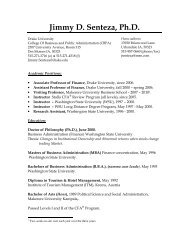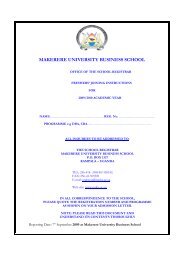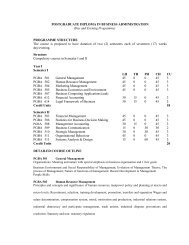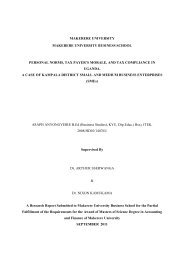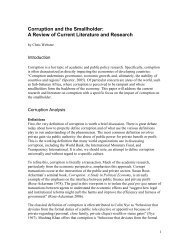13th Annual International Management Conference Proceeding
13th Annual International Management Conference Proceeding
13th Annual International Management Conference Proceeding
Create successful ePaper yourself
Turn your PDF publications into a flip-book with our unique Google optimized e-Paper software.
changes and sustainable improvements. Though they may act locally, their actions have the potential to<br />
stimulate global improvements in their chosen arenas, whether that is education, health care, economic<br />
development, the environment, the arts, or any other social field.<br />
Adopting a mission to create and sustain social value: This is the core of what distinguishes social<br />
entrepreneurs from business entrepreneurs even from socially responsible businesses. For a social<br />
entrepreneur, the social mission is fundamental. This is a mission of social improvement that cannot be<br />
reduced to creating private benefits (financial returns or consumption benefits) for individuals. Making a<br />
profit, creating wealth, or serving the desires of customers may be part of the model, but these are means to a<br />
social end, not the end in itself. Profit is not the gauge of value creation; nor is customer satisfaction; social<br />
impact is the gauge. Social entrepreneurs look for a long-term social return on investment. Social<br />
entrepreneurs want more than a quick hit; they want to create lasting improvements. They think about<br />
sustaining the impact.<br />
Recognizing and relentlessly pursuing new opportunities: Where others see problems, social entrepreneurs<br />
see opportunity. They are not simply driven by the perception of a social need or by their compassion, rather<br />
they have a vision of how to achieve improvement and they are determined to make their vision work. They<br />
are persistent. The models they develop and the approaches they take can, and often do, changes, as the<br />
entrepreneurs learn about what works and what does not work. The key element is persistence combined<br />
with a willingness to make adjustments as one goes. Rather than giving up when an obstacle is encountered,<br />
entrepreneurs ask, “How can we surmount this obstacle? How can we make this work?”<br />
Engaging in a process of continuous innovation, adaptation, and learning: Entrepreneurs are innovative. They<br />
break new ground; develop new models, and pioneer new approaches. However, as Schumpeter notes,<br />
innovation can take many forms. It does not require inventing something wholly new; it can simply involve<br />
applying an existing idea in a new way or to a new situation. Entrepreneurs need not be inventors. They<br />
simply need to be creative in applying what others have invented. Their innovations may appear in how they<br />
structure their core programs or in how they assemble the resources and fund their work. On the funding<br />
side, social entrepreneurs look for innovative ways to assure that their ventures will have access to resources<br />
as long as they are creating social value. This willingness to innovate is part of the modus operandi of<br />
entrepreneurs. It is not just a one-time burst of creativity. It is a continuous process of exploring, learning,<br />
and improving. Of course, with innovation comes uncertainty and risk of failure. Entrepreneurs tend to have<br />
a high tolerance for ambiguity and learn how to manage risks for themselves and others. They treat failure of<br />
a project as a learning experience, not a personal tragedy.<br />
Acting boldly without being limited by resources currently in hand: Social entrepreneurs do not let their own<br />
limited resources keep them from pursuing their visions. They are skilled at doing more with less and at<br />
attracting resources from others. They use scarce resources efficiently, and they leverage their limited<br />
resources by drawing in partners and collaborating with others. They explore all resource options, from pure<br />
philanthropy to the commercial methods of the business sector. They are not bound by sector norms or<br />
traditions. They develop resource strategies that are likely to support and reinforce their social missions.<br />
They take calculated risks and manage the downside, so as to reduce the harm that will result from failure.<br />
They understand the risk tolerances of their stakeholders and use this to spread the risk to those who are<br />
better prepared to accept it.<br />
Exhibiting a heightened sense of accountability to the constituencies served and for the outcomes created:<br />
Because market discipline does not automatically weed out inefficient or ineffective social ventures, social<br />
entrepreneurs take steps to assure they are creating value. This means that they seek a sound understanding<br />
of the constituencies they are serving. They make sure they have correctly assessed the needs and values of<br />
the people they intend to serve and the communities in which they operate. In some cases, this requires close<br />
connections with those communities. They understand the expectations and values of their “investors,”<br />
including anyone who invests money, time, and/or expertise to help them. They seek to provide real social<br />
improvements to their beneficiaries and their communities, as well as attractive (social and/or financial)<br />
return to their investors. Creating a fit between investor values and community needs is an important part of<br />
the challenge. When feasible, social entrepreneurs create market-like feedback mechanisms to reinforce this<br />
67




